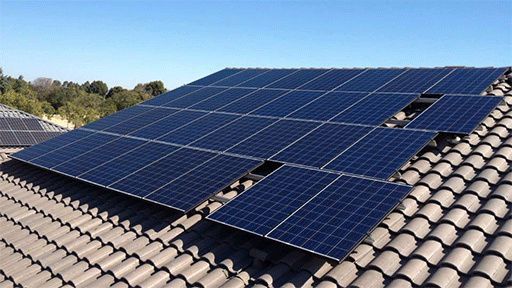A vote by the California Public Utilities Commission (CPUC) voted to slash rooftop solar incentives for new customers.
It’s estimated that those with solar panels will now have decreased compensation (estimated at 75% less credit) when they send the power back into the grid. The plan only impacts new solar customers and not current customers.
State leaders say the current rate structure benefits those who can afford solar panels at the expense of those who cannot. The plan also supports more energy storage. Those against the policy change argued the state should be encouraging solar, not discouraging rooftop solar. They say with current solar incentives, it helped led to over 1.5 million solar roofs and counting.
Here is the release put out by the CPUC today:
CPUC Modernizes Solar Tariff To Support Reliability and Decarbonization
The California Public Utilities Commission (CPUC) today issued a decision that modernizes the Net Energy Metering (NEM) solar tariff to promote grid reliability, incentivizes solar and battery storage, and controls electricity costs for all Californians. The decision has no impact on existing rooftop solar customers, maintaining their current compensation rates.
“We are launching the solar and storage industry into the future so that it can support the modern grid,” said President Alice Reynolds. “The new tariff promotes solar systems and battery storage with a focus on equity and advances the new clean energy technologies we need to meet our climate goals and help ensure grid reliability.”
Commissioner Clifford Rechtschaffen noted, “The decision strikes the right balance between many competing priorities and advances our overarching goals of ensuring California meets its climate and clean energy goals equitably.”
“Today’s decision will bring rooftop solar into a new and more sustainable age. NEM has left an incredible legacy and brought solar to hundreds of thousands of Californians, but it is also profoundly expensive for non-solar customers and was overdue for reform,” said Commissioner John Reynolds. “The future needs a solar program designed around the value of solar to the grid and one that encourages true carbon reductions at peak energy times, which is after the sun goes down, by creating better incentives for customers to pair solar with batteries. The Net Billing Tariff will sustain solar and reduce costs to non-solar customers while driving a new era of storage adoption.”
The decision improves the pricing structure and credits to new rooftop solar customers of Pacific Gas and Electric Company, Southern California Edison, and San Diego Gas & Electric for the electricity they export based on its value to the grid. The new tariff supplements and bolsters federal incentives provided by the Inflation Reduction Act for solar and battery storage. The new tariff also works together with an additional $630 million in state funding that the Legislature has dedicated to upfront incentives for low-income customers who install solar plus battery storage.
Under the new tariff, average residential customers who install solar are expected to save $100 a month on their electricity bill, and average residential customers who install solar paired with battery storage are expected to save at least $136 a month. With these savings on their electricity bills, new solar and solar plus battery storage customers should fully pay off their systems in just 9 years or less on average.
To support the evolution and growth of the solar industry, the decision provides extra bill credits to residential customers who adopt solar over the next five years, allowing California businesses to gradually transition from solar-only sales to solar plus battery storage sales, fostering a stronger local economy. The decision also allows residential customers, small and large businesses, nonprofits, schools, and governments to lock in their export credits for 9 years to provide certainty and predictability of bill savings.
The tariff promotes equity by providing low-income customers, residents living in disadvantaged communities, and residents living in California Indian Country more than double the amount of extra bill credits to improve access to solar and storage.
The new tariff:
- Applies new residential rates to encourage electricity use when it is most beneficial for grid reliability. These rates have significant differences between peak and off-peak prices to incent battery storage and load shifting from evening hours to overnight or midday hours. The rates incentivize adoption of technologies to replace the use of fossil fuels such as battery storage, electric vehicles, and heat pump water heaters, all of which are important for achieving carbon neutrality.
- Credits solar and solar plus battery storage customers for the electricity they export to the grid based on its value, as determined by the avoided cost to their utility of buying clean electricity elsewhere. This will promote solar exports during the late afternoon and early evening hours, particularly in the summer, when the grid is the most stressed.
- Provides extra electricity bill credits to residential customers who adopt solar or solar paired with battery storage in the next five years, which are paid on top of the avoided cost bill credits. Customers are guaranteed these extra bill credits for 9 years.
- Expands access to solar and storage for low-income customers, residents living in disadvantaged communities, and residents living in California Indian Country by providing a larger amount of extra bill credits.
- Increases the allowable size of rooftop solar systems to cover 150 percent of a customer’s electricity usage to accommodate future electrification of appliances and vehicles.
- Does not include any charges specific to solar customers.
Assembly Bill 327 (Perea, 2013) requires the CPUC to reform the NEM program, as well as conduct rate reform and distribution planning activities. Since 1997, California has supported the rooftop solar market through its NEM tariffs, which have enabled 1.5 million customers to install more than 12,000 megawatts of renewable generation. Due to the success of California’s Renewables Portfolio Standard policies and the NEM tariff, California supplies a significant amount of its electricity needs during mid-day hours from renewable and zero-carbon energy resources.
To further reduce greenhouse gas emissions from electric generation, the decision issued today incentivizes customers to install battery storage so they can store solar electricity produced in the daytime and export it in the evening, when the grid needs it the most for reliability and displacing fossil fuels. The decision also controls electricity costs and improves electric bill affordability for all Californians by creating more grid value, with payments to new solar and solar plus storage customers calibrated to that value.
The proposal voted on is available at docs.cpuc.ca.gov/PublishedDocs/Published/G000/M499/K921/499921246.PDF.
To read the decision a fact sheet, Q&A, and more information, please visit cpuc.ca.gov/nemrevisit.
The CPUC regulates services and utilities, safeguards the environment, and assures Californians’ access to safe and reliable utility infrastructure and services. For more information on the CPUC, please visit www.cpuc.ca.gov.
Clean Energy Advocate, Environment California
CPUC votes to cut California’s solar incentives, threatening clean energy progress
LOS ANGELES — Under a revised decision finalized by the California Public Utilities Commission (CPUC) Thursday, effective April 2023, new California solar customers will suffer a sudden 80% cut in a key solar incentive.
The CPUC’s “revised decision” contained only minor changes from the commission’s November draft. Clean energy advocates warned that the proposal would discourage Californians from “going solar” at a time when the state needs more, not less, renewable energy to replace polluting fossil fuels.
California compensates current solar customers for excess power they generate and sell back to the publicly accessible grid under an incentive program called “net energy metering (NEM).” The commission vote means that in April, new solar customers will get an 80% lower net metering credit, with steeper cuts to come in subsequent years.
History shows that when drastic cuts are made to NEM programs, people stop putting panels on their rooftops. Nevada’s January 2016 cut to NEM compensation led to a 47% reduction in residential solar installations year over year. After Nevada restored net metering in September 2017, residential solar adoption returned to its earlier level after two years. California’s Imperial Irrigation District abandoned net metering in July 2016, causing residential solar installations to decline 88% over two years.
Although California produces more solar energy than any other state, it will need to quadruple its rooftop solar capacity to meet its climate and clean energy goals, including generating 100% of its power from clean energy sources by 2045. With drastically lower incentives, many Californians may be unable to afford the upfront costs of this technology that has so many long-term benefits.
The final decision is not as egregious as an initial proposal put forward last year. Like the November draft, it still honors existing net metering compensation agreements. Also, it does not include an unfair “solar tax” or grid-participation fee for people with their own solar panels.
In response, Environment California State Director Laura Deehan and Johanna Neumann, Senior Director of the Campaign for 100% Renewable Energy at Environment America released the following statement:
“It’s devastating to see California’s Utility Commission vote to dismantle solar incentives that have made California the nation’s leader in solar power,” said Deehan “Rooftop solar is a critical part of our clean energy transition, and we need to accelerate deployment. Governor Newsom and the CPUC should be making clean energy more accessible and affordable so that rooftops across the state can catch the sun to power our lives. This misguided decision, which undervalues solar’s numerous benefits for all Californians, will dim the lights on the growth of solar in the Golden State.”
“Given our urgent need to transition to clean energy it’s mind-boggling that America’s undisputed solar leader is cutting solar incentives,” said Neumann. “Without robust alternatives in place to make sure rooftop solar can thrive, this decision by the world’s 4th-largest economy puts the future of one of America’s best and most popular clean energy technologies at risk. Given what we know about all the clean air and climate benefits that come with rooftop solar, this decision in California flies in the face of the state’s climate and clean energy goals.”


2 comments
I was on the PUC call yesterday for nearly 2 hours. NOT ONE PERSON GAVE FEEDBACK THAT THEY LIKED THE PLAN!!! NOT ONE!!!
It is time we, the people Of California, rise yet again with a new Proposition that will:
1. Go back to NEMS 2.0 until a proper study with representation and equal voting by solar home owners can truly figure out NEMS 3.0!
2. Mandate that all electricity public energy providing utilities in California must include solar home owners in any future solar proposals
The only other choice, as I see it, is to have SOLAR BOYCOTT DAYS! Yes, a day in which most/all solar home owners simply shut-off their solar exports to protest — something I believe will bring the grid down to its knees and in turn get the CA Public Utilities providing electricity to change the tune of their song.
Solar isn’t what makes electricity increasingly expensive. It’s the companies having up pay off their lawsuits and the wasteful way they pay their employees. Total BS.
Comments are closed.